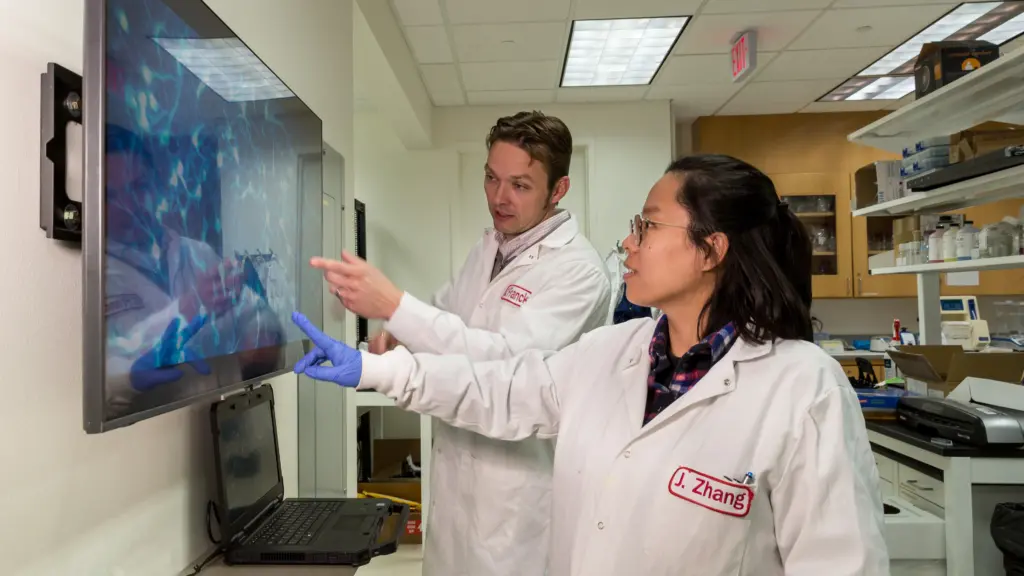An interdisciplinary research initiative led by the University of Wisconsin-Madison is emerging as a global leader in developing better technologies for detecting and preventing concussions and other traumatic brain injuries.
Christian Franck, Bjorn Borgen Professor in mechanical engineering at UW-Madison, started the initiative, called PANTHER, in 2017. Under his leadership, it has grown to include more than 25 principal investigators nationwide, bringing together scientists from academia, industry and government to study traumatic brain injury through a range of approaches.
 Professor Christian Franck and Assistant Scientist Jing Zhang examine an image of brain cells in Franck’s lab. Credit: Joel Hallberg.
Professor Christian Franck and Assistant Scientist Jing Zhang examine an image of brain cells in Franck’s lab. Credit: Joel Hallberg.
“There are a lot of research programs on traumatic brain injury around the country and the world, but most of them are focused on helping people after an injury has occurred,” says Franck. “We are really taking the lead on enabling advanced detection of concussions and developing improved protective gear and guidelines to help prevent these injuries.”
So far, the researchers have achieved many high-impact scientific advances and made significant progress in addressing the challenges of traumatic brain injuries. In 2021, for example, they discovered a new cellular pathology for traumatic brain injury that is caused by exposure to an explosion. In his research, Franck used a unique in vitro lab setup that allowed him to mimic the effects of an explosion on neural cells. He found that the blast-like conditions produced physical injuries to the brain cells that were strikingly different from the type of brain injury caused by a fall or blow to the head.
“This was a major discovery of a new kind of injury to the brain, and it has huge implications on how the brain recovers and treatment approaches,” Franck says.
Franck believes this new cellular injury pathology could be occurring in the mysterious cases of “Havana Syndrome,” in which U.S. personnel serving both at home and abroad have experienced sudden onsets of concussion-like symptoms, such as severe headaches, dizziness and nausea. The researchers are investigating a hypothesis that directed microwave attacks caused the Havana symptoms by producing rapid strain on brain tissue.
They’ve also identified the force thresholds—the levels of brain tissue strain and strain rate—for injury in this new pathology. That baseline is crucial knowledge as they seek solutions for better detecting or preventing brain injury.
These cellular injury thresholds can, for example, be used in the high-fidelity computational models of the human head and brain that PANTHER researchers have developed. The team uses these models to simulate head impacts and predict the resulting strain in the brain tissue. Then, based on the injury threshold data, the researchers can make better predictions about a person’s concussion risk.
“This is really important because traumatic brain injury can occur without symptoms or with inconsistent symptoms,” Franck says. “Since we can’t rely on a symptom like dizziness to indicate injury, these simulations are currently our best predictor of injury. We can measure something like a punch to the head or a soccer header and run it through the simulation to predict the response of the brain and see if a given exposure is likely to cause injury.”
To measure impacts like soccer headers, Joseph Andrews, an assistant professor in mechanical engineering and electrical and computer engineering at UW-Madison, is developing advanced head sensors that can be worn like a thin headband to measure impact forces and head motion. The team also developed an algorithm that will use the sensor data to reconstruct human head motion with unprecedented resolution and accuracy.
In addition, the researchers have created a unique infrastructure for characterizing advanced helmet liner materials, including topological and structural materials, across a wide range of loading conditions and temperatures relevant to helmet use. This infrastructure is highly useful for industry partners in the program, including helmet manufacturer Team Wendy.
Prior to PANTHER, there was limited testing available to industry for characterizing a new soft protective material’s properties compared to engineering materials like steel or concrete. Now, PANTHER researchers have developed ways to test foams to extract the important properties for material designers.
“Our framework for material testing and characterization finally allows engineers to predict helmet performance for a prescribed impact. We can now optimize helmet liners by tuning the material properties,” Franck says. “This infrastructure is unique to PANTHER and unique in the world.”
Recently, the U.S. Office of Naval Research awarded PANTHER nearly $5 million in new funding to advance its groundbreaking research. Partners in PANTHER include researchers from Brown University, Robert Morris University, Colorado School of Mines, the University of Texas, Arlington, the University of Southern California, Iowa State University, UC Santa Barbara, Johns Hopkins University, Washington University in St. Louis, and Sandia National Laboratories. Industry partners include Team Wendy, Trek Bicycle and Milwaukee Tool. Additional collaborators from the University of Wisconsin-Madison College of Engineering include Engineering Physics Assistant Professor Ramathasan Thevamaran, Biomedical Engineering Assistant Professor Aviad Hai, and Mechanical Engineering Assistant Professor Shiva Rudraraju.
Featured photo caption: Undergraduate researcher Grace Kreissler holds a clear 3D-printed skull that the researchers created to aid in their investigation of traumatic brain injuries. Credit: Joel Hallberg.
Professor Christian Franck, Mechanical Engineering, UW–Madison